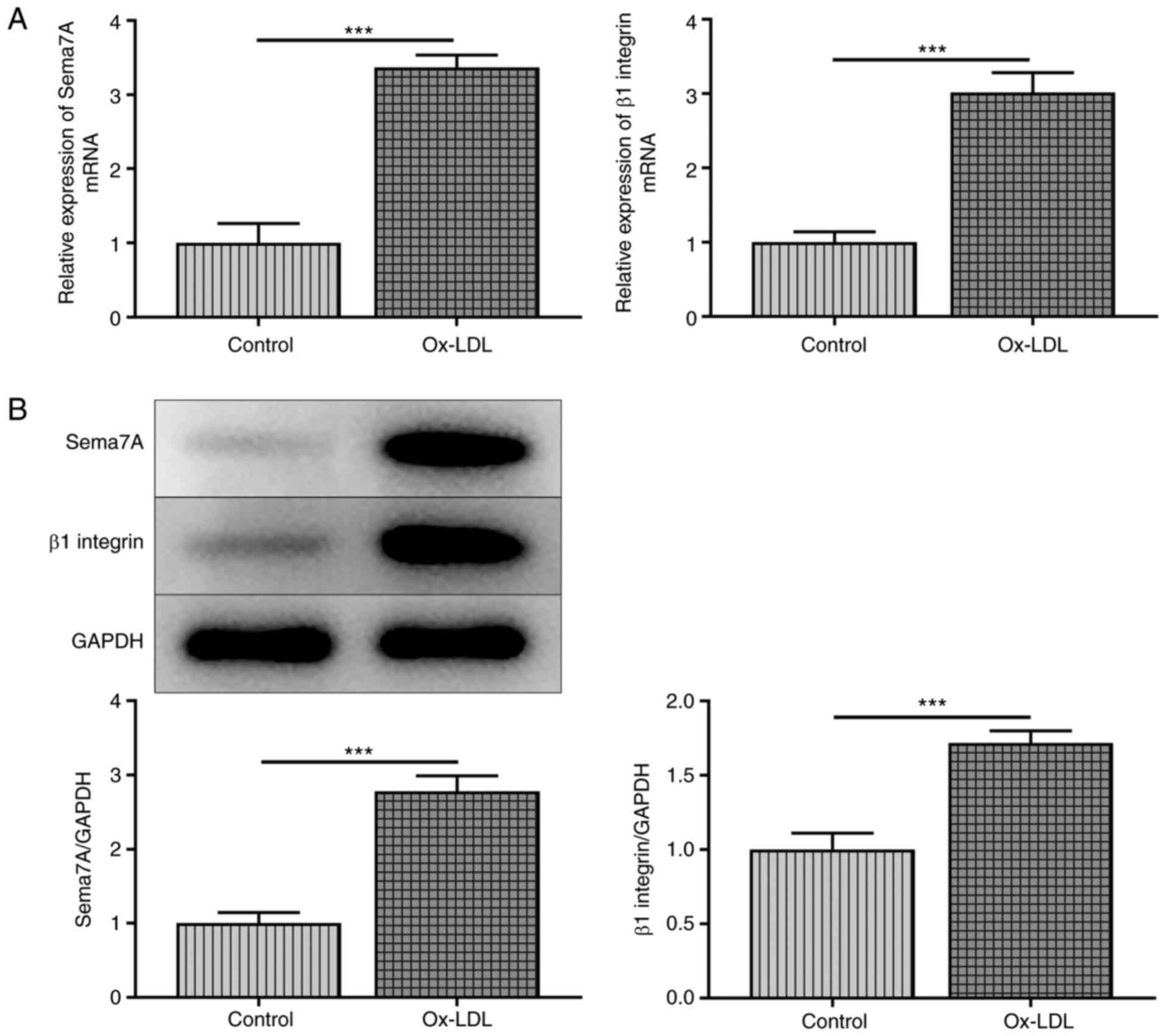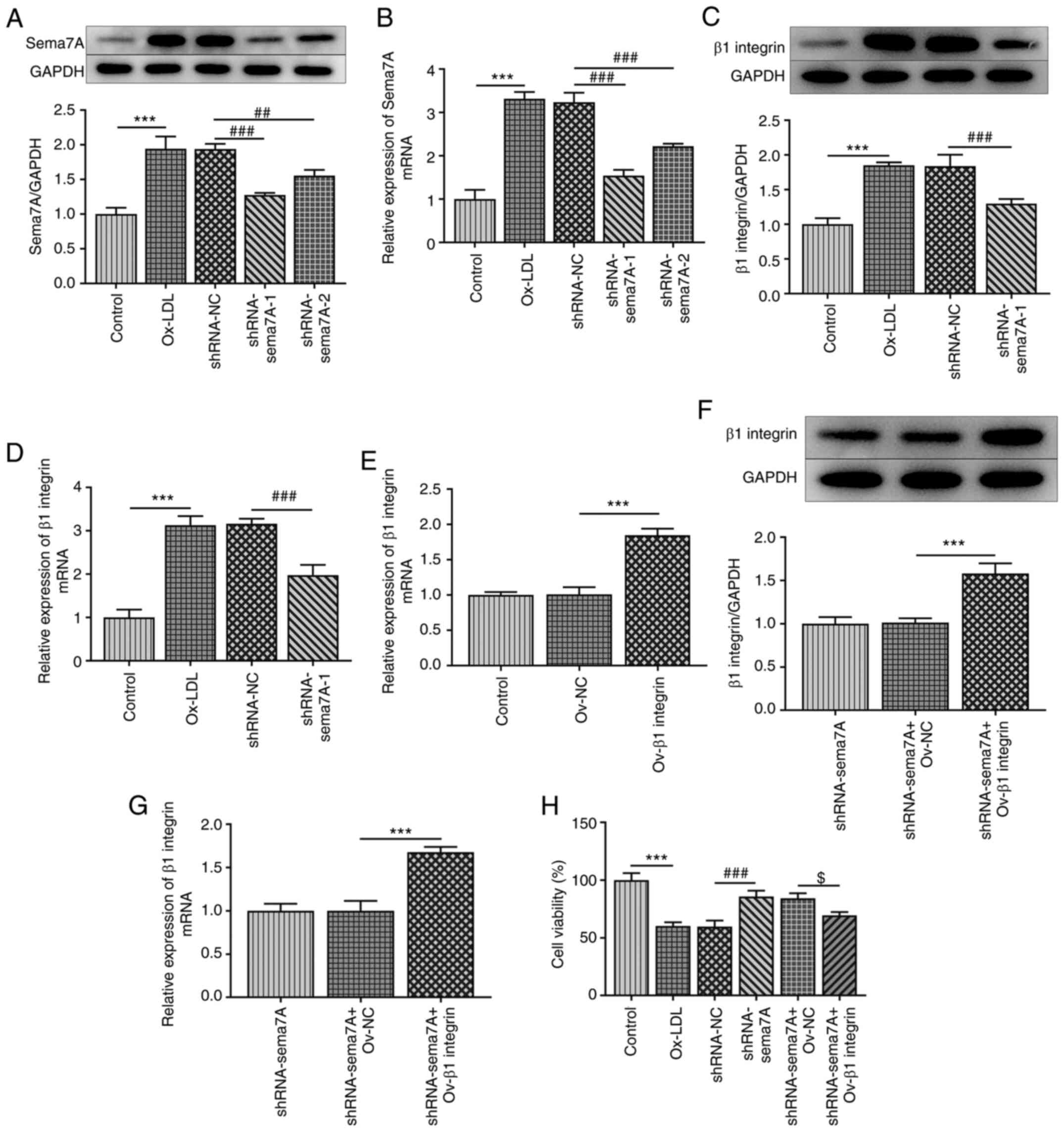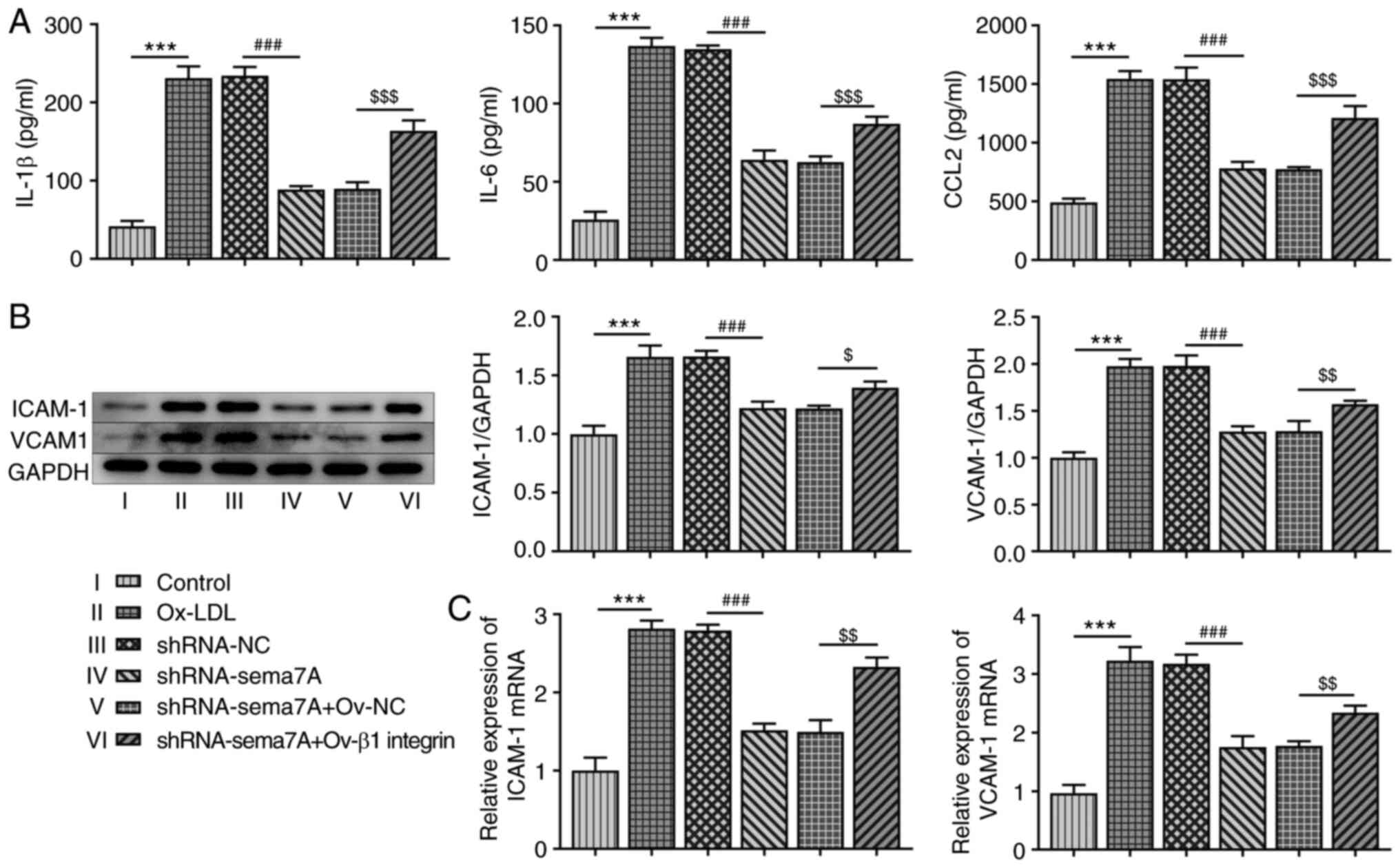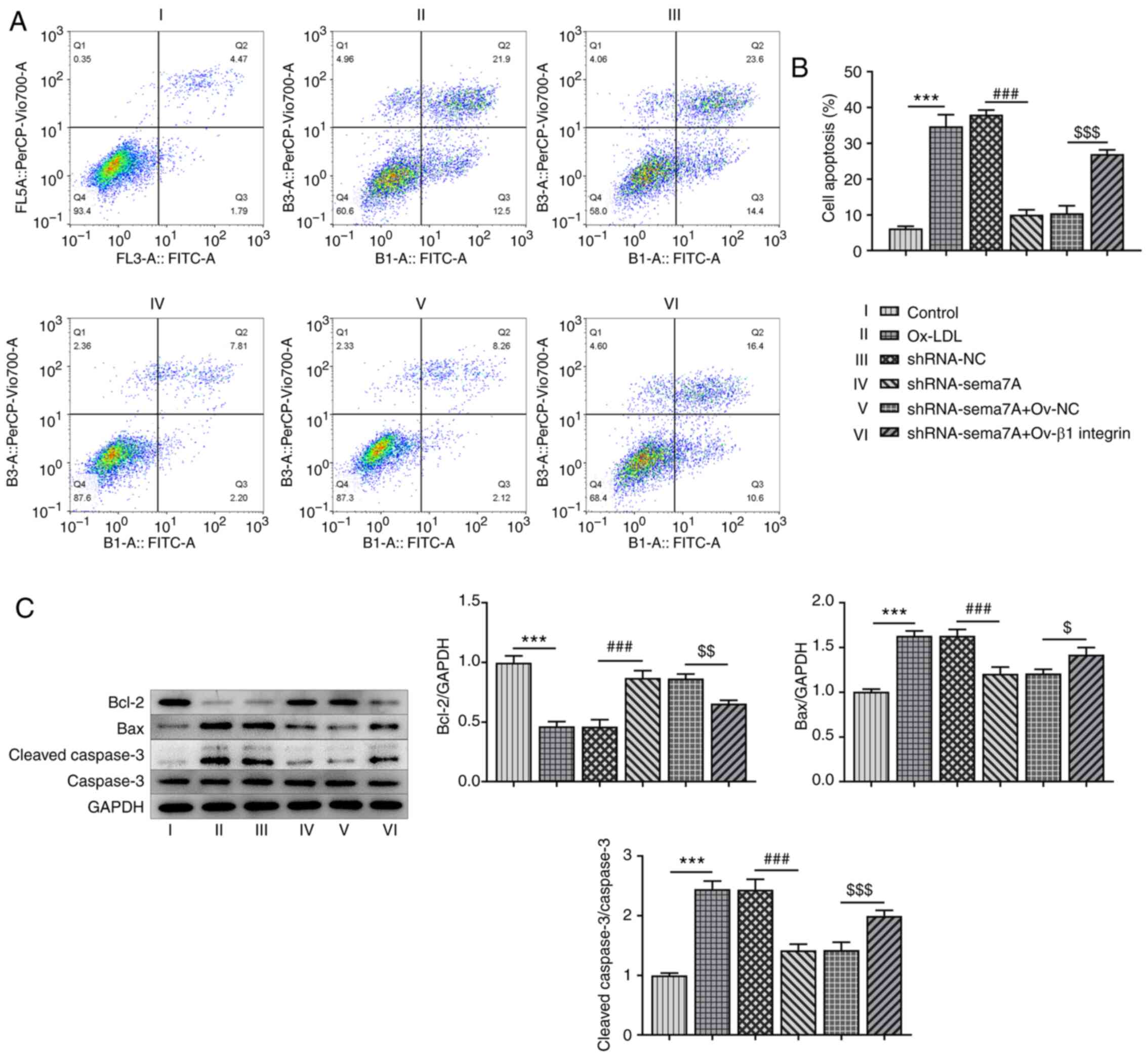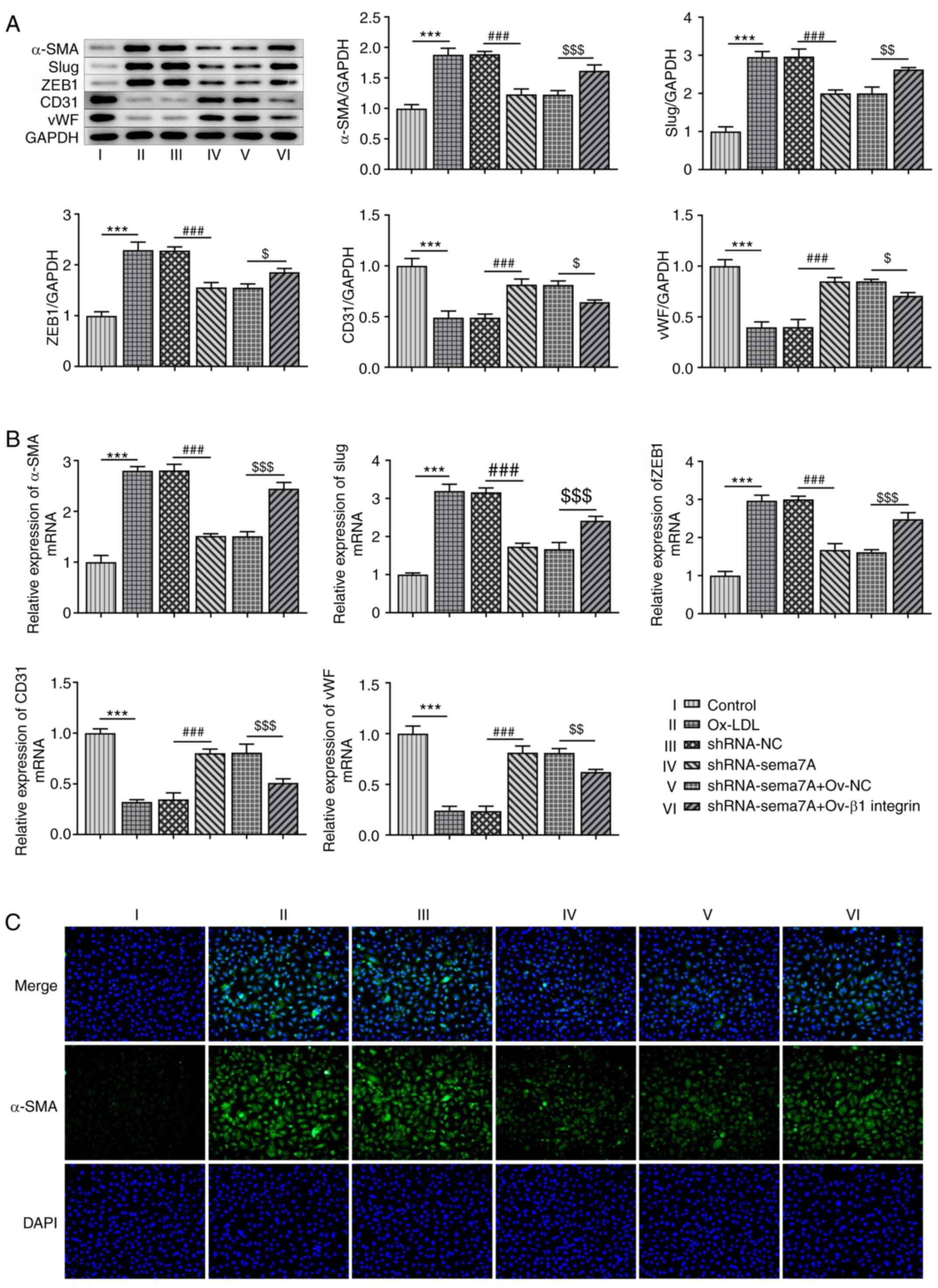|
1
|
Abdolmaleki F, Gheibi Hayat SM, Bianconi
V, Johnston TP and Sahebkar A: Atherosclerosis and immunity: A
perspective. Trends Cardiovasc Med. 29:363–371. 2019.PubMed/NCBI View Article : Google Scholar
|
|
2
|
Taleb S: Inflammation in atherosclerosis.
Arch Cardiovasc Dis. 109:708–715. 2016.PubMed/NCBI View Article : Google Scholar
|
|
3
|
Viola J and Soehnlein O: Atherosclerosis -
A matter of unresolved inflammation. Semin Immunol. 27:184–193.
2015.PubMed/NCBI View Article : Google Scholar
|
|
4
|
Falk E: Pathogenesis of atherosclerosis. J
Am Coll Cardiol. 47 (Suppl 1):C7–C12. 2006.PubMed/NCBI View Article : Google Scholar
|
|
5
|
Davies MJ, Woolf N, Rowles PM and Pepper
J: Morphology of the endothelium over atherosclerotic plaques in
human coronary arteries. Br Heart J. 60:459–464. 1988.PubMed/NCBI View Article : Google Scholar
|
|
6
|
Wolf D and Ley K: Immunity and
inflammation in atherosclerosis. Circ Res. 124:315–327.
2019.PubMed/NCBI View Article : Google Scholar
|
|
7
|
Zhu Y, Xian X, Wang Z, Bi Y, Chen Q, Han
X, Tang D and Chen R: research progress on the relationship between
atherosclerosis and inflammation. Biomolecules.
8(E80)2018.PubMed/NCBI View Article : Google Scholar
|
|
8
|
Correia AC, Moonen JR, Brinker MG and
Krenning G: FGF2 inhibits endothelial-mesenchymal transition
through microRNA-20a-mediated repression of canonical TGF-β
signaling. J Cell Sci. 129:569–579. 2016.PubMed/NCBI View Article : Google Scholar
|
|
9
|
Kovacic JC, Mercader N, Torres M, Boehm M
and Fuster V: Epithelial-to-mesenchymal and
endothelial-to-mesenchymal transition: From cardiovascular
development to disease. Circulation. 125:1795–1808. 2012.PubMed/NCBI View Article : Google Scholar
|
|
10
|
Chen PY, Qin L, Baeyens N, Li G, Afolabi
T, Budatha M, Tellides G, Schwartz MA and Simons M:
Endothelial-to-mesenchymal transition drives atherosclerosis
progression. J Clin Invest. 125:4514–4528. 2015.PubMed/NCBI View
Article : Google Scholar
|
|
11
|
Hansson GK and Hermansson A: The immune
system in atherosclerosis. Nat Immunol. 12:204–212. 2011.PubMed/NCBI View
Article : Google Scholar
|
|
12
|
Simpson KJ, Henderson NC, Bone-Larson CL,
Lukacs NW, Hogaboam CM and Kunkel SL: Chemokines in the
pathogenesis of liver disease: So many players with poorly defined
roles. Clin Sci (Lond). 104:47–63. 2003.PubMed/NCBI
|
|
13
|
Wannemacher KM, Wang L, Zhu L and Brass
LF: The role of semaphorins and their receptors in platelets:
Lessons learned from neuronal and immune synapses. Platelets.
22:461–465. 2011.PubMed/NCBI View Article : Google Scholar
|
|
14
|
Suzuki K, Kumanogoh A and Kikutani H:
Semaphorins and their receptors in immune cell interactions. Nat
Immunol. 9:17–23. 2008.PubMed/NCBI View
Article : Google Scholar
|
|
15
|
Gutiérrez-Franco A, Eixarch H, Costa C,
Gil V, Castillo M, Calvo-Barreiro L, Montalban X, Del Río JA and
Espejo C: Semaphorin 7A as a potential therapeutic target for
multiple sclerosis. Mol Neurobiol. 54:4820–4831. 2017.PubMed/NCBI View Article : Google Scholar
|
|
16
|
Pasterkamp RJ, Peschon JJ, Spriggs MK and
Kolodkin AL: Semaphorin 7A promotes axon outgrowth through
integrins and MAPKs. Nature. 424:398–405. 2003.PubMed/NCBI View Article : Google Scholar
|
|
17
|
Ma B, Herzog EL, Lee CG, Peng X, Lee CM,
Chen X, Rockwell S, Koo JS, Kluger H, Herbst RS, et al: Role of
chitinase 3-like-1 and semaphorin 7a in pulmonary melanoma
metastasis. Cancer Res. 75:487–496. 2015.PubMed/NCBI View Article : Google Scholar
|
|
18
|
Suzuki K, Okuno T, Yamamoto M, Pasterkamp
RJ, Takegahara N, Takamatsu H, Kitao T, Takagi J, Rennert PD,
Kolodkin AL, et al: Semaphorin 7A initiates T-cell-mediated
inflammatory responses through alpha1beta1 integrin. Nature.
446:680–684. 2007.PubMed/NCBI View Article : Google Scholar
|
|
19
|
Hu S, Liu Y, You T and Zhu L: Semaphorin
7A promotes VEGFA/VEGFR2-mediated angiogenesis and intraplaque
neovascularization in ApoE-/- mice. Front Physiol.
9(1718)2018.PubMed/NCBI View Article : Google Scholar
|
|
20
|
You T, Zhu Z, Zheng X, Zeng N, Hu S, Liu
Y, Ren L, Lu Q, Tang C, Ruan C, et al: Serum semaphorin 7A is
associated with the risk of acute atherothrombotic stroke. J Cell
Mol Med. 23:2901–2906. 2019.PubMed/NCBI View Article : Google Scholar
|
|
21
|
Wang GL, Xia XL, Li XL, He FH and Li JL:
Identification and expression analysis of the MSP130-related-2 gene
from Hyriopsis cumingii. Genet Mol Res. 14:4903–4913.
2015.PubMed/NCBI View Article : Google Scholar
|
|
22
|
Fang F, Yang Y, Yuan Z, Gao Y, Zhou J,
Chen Q and Xu Y: Myocardin-related transcription factor A mediates
OxLDL-induced endothelial injury. Circ Res. 108:797–807.
2011.PubMed/NCBI View Article : Google Scholar
|
|
23
|
Stocker R and Keaney JF Jr: Role of
oxidative modifications in atherosclerosis. Physiol Rev.
84:1381–1478. 2004.PubMed/NCBI View Article : Google Scholar
|
|
24
|
Sun HJ, Hou B, Wang X, Zhu XX, Li KX and
Qiu LY: Endothelial dysfunction and cardiometabolic diseases: Role
of long non-coding RNAs. Life Sci. 167:6–11. 2016.PubMed/NCBI View Article : Google Scholar
|
|
25
|
Sun HJ, Zhu XX, Cai WW and Qiu LY:
Functional roles of exosomes in cardiovascular disorders: A
systematic review. Eur Rev Med Pharmacol Sci. 21:5197–5206.
2017.PubMed/NCBI View Article : Google Scholar
|
|
26
|
Grover-Páez F and Zavalza-Gómez AB:
Endothelial dysfunction and cardiovascular risk factors. Diabetes
Res Clin Pract. 84:1–10. 2009.PubMed/NCBI View Article : Google Scholar
|
|
27
|
Pober JS, Min W and Bradley JR: Mechanisms
of endothelial dysfunction, injury, and death. Annu Rev Pathol.
4:71–95. 2009.PubMed/NCBI View Article : Google Scholar
|
|
28
|
Zhang Y, Mu Q, Zhou Z, Song H, Zhang Y, Wu
F, Jiang M, Wang F, Zhang W, Li L, et al: Protective effect of
irisin on atherosclerosis via suppressing oxidized low density
lipoprotein induced vascular inflammation and endothelial
dysfunction. PLoS One. 11(e0158038)2016.PubMed/NCBI View Article : Google Scholar
|
|
29
|
Lee WJ, Ou HC, Hsu WC, Chou MM, Tseng JJ,
Hsu SL, Tsai KL and Sheu WH: Ellagic acid inhibits oxidized
LDL-mediated LOX-1 expression, ROS generation, and inflammation in
human endothelial cells. J Vasc Surg. 52:1290–1300. 2010.PubMed/NCBI View Article : Google Scholar
|
|
30
|
Onat D, Brillon D, Colombo PC and Schmidt
AM: Human vascular endothelial cells: A model system for studying
vascular inflammation in diabetes and atherosclerosis. Curr Diab
Rep. 11:193–202. 2011.PubMed/NCBI View Article : Google Scholar
|
|
31
|
Maugeri N, Rovere-Querini P, Baldini M,
Sabbadini MG and Manfredi AA: Translational mini-review series on
immunology of vascular disease: Mechanisms of vascular inflammation
and remodelling in systemic vasculitis. Clin Exp Immunol.
156:395–404. 2009.PubMed/NCBI View Article : Google Scholar
|
|
32
|
Marui N, Offermann MK, Swerlick R, Kunsch
C, Rosen CA, Ahmad M, Alexander RW and Medford RM: Vascular cell
adhesion molecule-1 (VCAM-1) gene transcription and expression are
regulated through an antioxidant-sensitive mechanism in human
vascular endothelial cells. J Clin Invest. 92:1866–1874.
1993.PubMed/NCBI View Article : Google Scholar
|
|
33
|
Tsouknos A, Nash GB and Rainger GE:
Monocytes initiate a cycle of leukocyte recruitment when cocultured
with endothelial cells. Atherosclerosis. 170:49–58. 2003.PubMed/NCBI View Article : Google Scholar
|
|
34
|
Lutgens E, de Muinck ED, Kitslaar PJ,
Tordoir JH, Wellens HJ and Daemen MJ: Biphasic pattern of cell
turnover characterizes the progression from fatty streaks to
ruptured human atherosclerotic plaques. Cardiovasc Res. 41:473–479.
1999.PubMed/NCBI View Article : Google Scholar
|
|
35
|
Wu CY, Tang ZH, Jiang L, Li XF, Jiang ZS
and Liu LS: PCSK9 siRNA inhibits HUVEC apoptosis induced by ox-LDL
via Bcl/Bax-caspase9-caspase3 pathway. Mol Cell Biochem.
359:347–358. 2012.PubMed/NCBI View Article : Google Scholar
|
|
36
|
Zhong X, Ma X, Zhang L, Li Y, Li Y and He
R: MIAT promotes proliferation and hinders apoptosis by modulating
miR-181b/STAT3 axis in ox-LDL-induced atherosclerosis cell models.
Biomed Pharmacother. 97:1078–1085. 2018.PubMed/NCBI View Article : Google Scholar
|
|
37
|
Gong L, Lei Y, Liu Y, Tan F, Li S, Wang X,
Xu M, Cai W, Du B, Xu F, et al: Vaccarin prevents ox-LDL-induced
HUVEC EndMT, inflammation and apoptosis by suppressing ROS/p38 MAPK
signaling. Am J Transl Res. 11:2140–2154. 2019.PubMed/NCBI
|
|
38
|
Evrard SM, Lecce L, Michelis KC,
Nomura-Kitabayashi A, Pandey G, Purushothaman KR, d'Escamard V, Li
JR, Hadri L, Fujitani K, et al: Endothelial to mesenchymal
transition is common in atherosclerotic lesions and is associated
with plaque instability. Nat Commun. 7(11853)2016.PubMed/NCBI View Article : Google Scholar
|
|
39
|
Boström KI, Yao J, Guihard PJ,
Blazquez-Medela AM and Yao Y: Endothelial-mesenchymal transition in
atherosclerotic lesion calcification. Atherosclerosis. 253:124–127.
2016.PubMed/NCBI View Article : Google Scholar
|
|
40
|
Wesseling M, Sakkers TR, de Jager SCA,
Pasterkamp G and Goumans MJ: The morphological and molecular
mechanisms of epithelial/endothelial-to-mesenchymal transition and
its involvement in atherosclerosis. Vascul Pharmacol. 106:1–8.
2018.PubMed/NCBI View Article : Google Scholar
|
|
41
|
Hu S, Liu Y, You T, Heath J, Xu L, Zheng
X, Wang A, Wang Y, Li F, Yang F, et al: Vascular Semaphorin 7A
upregulation by disturbed flow promotes atherosclerosis through
endothelial β1 integrin. Arterioscler Thromb Vasc Biol. 38:335–343.
2018.PubMed/NCBI View Article : Google Scholar
|















